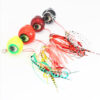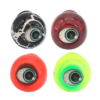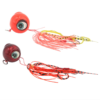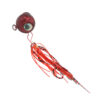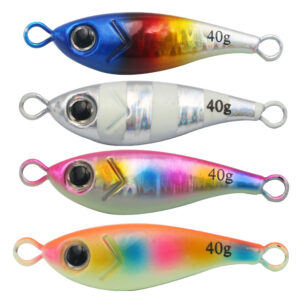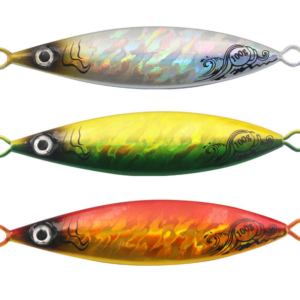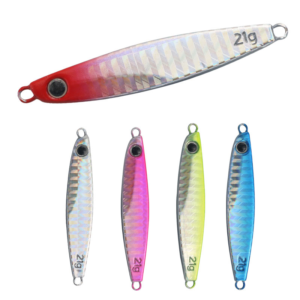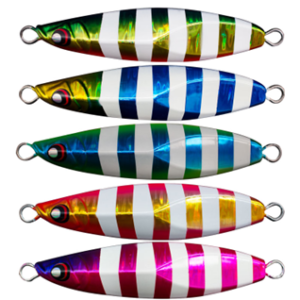Metal jigs are a staple in the angler’s toolkit, known for their effectiveness across various environments and species. With their durable, weighted design and realistic motion, metal jigs excel in attracting a wide range of fish, from saltwater predators to freshwater favorites. This guide will provide an in-depth look at everything you need to know about metal jig fishing—from selecting the right jig to applying advanced techniques. With these tips, you’ll be ready to bring in impressive catches using metal jigs.
Understanding the Appeal of Metal Jigs in Fishing
Metal jigs are versatile lures designed to imitate the appearance and erratic motion of distressed baitfish. Made from durable metals like lead or zinc, they are weighted to sink quickly and cover deeper depths with ease. Their fast, reflective fall and flutter action closely resemble injured or fleeing fish, an irresistible sight for predators.
In saltwater fishing, metal jigs are especially popular for species like tuna, amberjack, and grouper that feed near the ocean floor. However, they are equally effective in freshwater, attracting fish like bass, walleye, and trout. The natural look, wide depth range, and sturdy build of metal jigs make them a favorite among anglers for both saltwater and freshwater fishing.
Why Use Metal Jigs? Key Benefits of Metal Jig Fishing
- Adaptability Across Environments: Metal jigs can be used in various conditions and water types, including deep-sea environments, reefs, rocky areas, and open waters, making them highly adaptable.
- Effective Depth Control: The weight of metal jigs allows them to sink rapidly, reaching deeper parts of the water column quickly. This is especially beneficial for targeting bottom-dwelling fish or mid-depth feeders.
- Realistic Action and Appeal: Metal jigs mimic the natural, erratic motion of a wounded or panicked fish, which easily triggers a predatory response from nearby fish.
- Durable and Long-Lasting: Unlike soft plastics, metal jigs can withstand repeated use, rough underwater conditions, and bites from fish with strong teeth, providing great value over time.
- Multiple Techniques: Metal jigs support various jigging techniques, including vertical, high-speed, and slow-pitch jigging. This versatility makes them suitable for different species and fishing styles.
Choosing the Right Metal Jig for Your Fishing Style
- Size and Weight: Heavier jigs, such as those over 100 grams, are best for deep waters and areas with strong currents, as they sink quickly and remain stable. Lighter jigs (20-60 grams) work well for shallow water or for when targeting fish closer to the surface, as they have a slower, more pronounced flutter.
- Color and Finish: Bright colors like silver, gold, or holographic finishes are excellent in clear water, reflecting light to attract fish. In murkier water, UV colors, glow-in-the-dark finishes, or darker hues make jigs more visible.
- Shape and Profile: The shape of the jig affects its movement. Long, slim jigs sink faster and are better for quick retrieves, while flat-sided jigs have a wider flutter, creating more action on the fall—ideal for slow-pitch jigging or targeting less active fish.
- Hooks and Rigging: Most metal jigs come with assist hooks, which can be single or double. Double hooks offer extra security for larger fish, while single hooks can reduce snagging and make it easier to release fish.
Essential Metal Jigging Techniques to Master
- Vertical Jigging: In this technique, drop the jig directly below the boat until it hits the bottom, then raise and lower the rod in a rhythmic manner. This creates a vertical motion that simulates a struggling fish and is effective for fish at various depths. Make sure to jig the lure up and down through the water column to cover more area.
- High-Speed Jigging: This technique is popular for species like tuna, mackerel, and amberjack. Drop the jig to the desired depth, then retrieve it quickly with short rod jerks. The fast, erratic motion mimics a fleeing baitfish, making it highly attractive to aggressive, fast-moving predators.
- Slow-Pitch Jigging: Slow-pitch jigging allows the jig to flutter down in a controlled, slow movement between rod pulls. This keeps the jig in the strike zone longer and is perfect for bottom-feeding species like grouper, snapper, or halibut that prefer a slower-moving target.
- Long Drop Technique: For fish that are hesitant or wary, letting the jig fall in a long, slow drop with minimal jerking can attract strikes. The slow fall mimics a weakened fish, making it an easy target for nearby predators.
- Casting and Retrieving: For shallow water or nearshore fishing, casting metal jigs out and retrieving them at a moderate speed can be effective. This technique works well around reefs, rocky zones, and structures where fish may be hiding or feeding on baitfish.
Where and When to Use Metal Jigs
- Deep-Water or Offshore Fishing: Metal jigs are ideal for deep-sea fishing, where they can quickly sink to reach bottom-dwelling species such as grouper, cod, and snapper. Their design allows for effective fishing even at great depths.
- Structure Fishing: Structures like reefs, wrecks, and rocky formations often hold large populations of fish. Dropping a metal jig near these structures can entice fish hiding within them, increasing your chances of a catch.
- Fast-Current Areas: In areas with strong currents, metal jigs maintain control and stability better than lighter lures. This makes them ideal for fishing in rivers or offshore areas with fast-moving water.
- Low-Light Conditions: In low-light environments, such as early mornings, evenings, or murky waters, jigs with reflective or glow-in-the-dark finishes are more visible, attracting fish that may not respond to standard lures.
- Open Water for Pelagic Species: Metal jigs are also effective for targeting pelagic species in open waters, such as tuna, kingfish, and mahi-mahi. Their shape allows for fast and aggressive jigging, which attracts these larger, fast-swimming fish.
Advanced Metal Jig Fishing Tips for Success
- Experiment with Speed and Motion: Fish may respond differently to various jigging speeds and rhythms. Experiment by alternating between slow, moderate, and fast retrieves to determine what works best for that day and location.
- Invest in High-Sensitivity Gear: Using a sensitive rod and braided line allows you to feel even the slightest bites or line slack, making it easier to detect strikes and set the hook.
- Pay Attention to Slack Line: A sudden slack in the line can indicate a bite as the jig falls. If you notice your line going slack unexpectedly, set the hook immediately to capitalize on the fish’s reaction strike.
- Upgrade to Heavy-Duty Hooks: Some metal jigs come with standard hooks that may bend under pressure from large fish. Replace these with high-quality assist hooks if you’re targeting species known for strong bites.
- Match the Local Baitfish: Research local baitfish species to select a jig color and size that closely resembles them. This natural imitation can increase your chances of enticing a strike.
- Try Angled Drops and Retrieves: Instead of always dropping the jig straight down, try casting at an angle and letting it sink before retrieving. This approach can cover a wider area and attract more fish, especially in open water or areas with spread-out fish.
Common Metal Jig Fishing Mistakes and How to Avoid Them
- Incorrect Weight Selection: Choosing the wrong weight can affect how effectively your jig reaches and stays at the desired depth. Adjust your jig weight based on depth, current strength, and water clarity.
- Overlooking Water Conditions: Water clarity and light levels can greatly impact jig color effectiveness. Use reflective or bright colors in clear water and darker or UV-colored jigs in low-light conditions.
- Ignoring Hook Sharpness: Sharp hooks are essential for successful hook sets, especially with larger fish. Regularly check and sharpen your hooks to avoid missed strikes.
- Sticking to One Technique: Fish behavior varies by species, location, and time of day. If one jigging style isn’t working, switch it up to another technique. Adaptability is key to success with metal jigs.
- Fishing Too Quickly or Too Slowly: Metal jigging requires balance; jigging too aggressively may scare off cautious fish, while moving too slowly can reduce the jig’s attractive flutter. Experiment with different tempos to find what works best.
Conclusión
Metal jig fishing is a highly effective and adaptable technique for targeting a wide range of fish species. By understanding the different types of jigs, mastering essential techniques, and adapting to the environment, you can make the most of metal jigs on your fishing trips. These durable, versatile lures offer endless possibilities, whether you’re targeting deep-sea giants or freshwater predators. With these tips and techniques in mind, get ready to elevate your fishing game and enjoy the rewarding experience of metal jig fishing. So, grab your tackle, test out a few jigs, and see the difference metal jigging can make on your next adventure!





